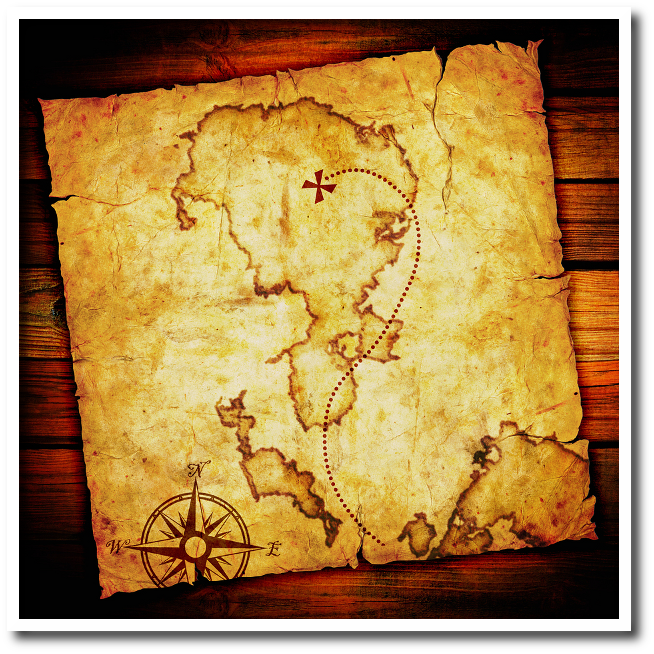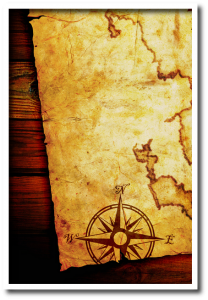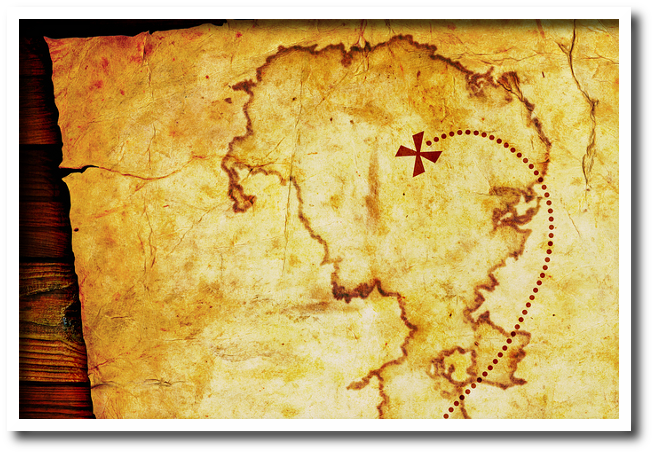The old treasure map shows the way to the island but it shows nothing of the surrounding area. Once you go beyond the edge of the map you are in unknown territory.
Your yoga pose is like that old map. If you stay in the known territory you are safe. If you go beyond the edge you are at risk. Every yoga pose has an edge and some yoga poses have several edges to contend with!
On the old treasure map you can see the edges all around you. In a yoga pose the edges are harder to see because they are internal.
What is your Edge
In a yoga pose your edge is that comfortable but challenging place to be. It is the point where you reach the maximum stretch in your muscles while it is still comfortable. Beyond this point discomfort increases and eventually it becomes a painful place to be.
Finding your edge is important to a safe and satisfying yoga practice.
Why is your Edge important
If you stay away from your edge, your muscles are relaxed and no stretching is happening. There is no increase in flexibility, you are sitting still.
On the other hand when you go beyond your edge you have gone into the danger zone. Your muscles are being stretched beyond their safe limits and injury is likely to occur.
Going up to your edge and not beyond in a yoga pose brings you the most benefit in the shortest amount of time. You are applying the maximum amount of stretch to your muscles while still keeping them safe from injury.
Finding your edge in a yoga pose, like finding the edge of the old map, is easy once you know how.
How do you find your Edge
To help you find your edge we are going to use Paschimottanasana. Most people have short hamstrings, so this yoga pose will easily show you where your edge is and how to find it.
Sit in Dandasana with your legs together out in front of you, your torso tall and your hands resting beside you.
Now set up your legs. Draw your toes towards you and bring the back of your hips to a vertical position. This will make the muscles in your legs active and ready to be stretched.
Now that your legs are ready it is time to move into Paschimottanasana and discover your edge.
Gradually bring the top of your hips and torso forward. Bring your hands along your shins towards your ankles and gaze towards your toes as you exhale.
That stretching sensation in your hamstrings is the path to your edge. As you start folding forward you are at the beginning of that path and you have not gone far enough yet to find your edge.
Not far enough
This movement of your hips and torso towards your feet will cause your hamstring muscles to stretch. Bring your awareness to this stretching sensation. This is how you are going to find your edge.
When the stretching sensation is comfortable and mild you have not reached your edge. You are moving down the path towards your edge but you are not there yet.
Too far
As you continue to move forward into Paschimottanasana the stretching sensation in your hamstrings will grow in intensity. Eventually the stretching will become uncomfortable. You will not want to stay in this position. Your body is asking you to back off. You feel like your muscles are going to pull apart. These are all signs that you have gone too far. You have gone beyond your edge. You are at risk of injuring yourself.
Now it is time to back off from this dangerous place.
At the edge
Ease up on your forward fold and reduce the intensity of the stretch in your hamstrings. Back up until the stretching sensations in your muscles is just bearable. You are searching for that comfortable but challenging place. The place where you can hold the stretch in your hamstrings for an extended period of time without fear of injuring them.
Once you find that comfortable but challenging place you have found your edge.
Is the Edge always in the same place?
Unlike the old map where the edges do not move, your edge in a yoga pose can move around.
You may discover one day that when you fold forward in Paschimottanasana that you are stopping sooner than usual. This means that your edge has moved and your muscles are not as flexible as they were the last time.
Rather than forcing yourself to the previous position of your edge, you respect the feedback from your body and work with your edge in this new location that way you avoid injuring yourself.
Your edge can move all by itself and sometimes you can make your edge move.
Can I move the Edge?
Once you have found your edge and can hold yourself there for a number of breaths you are ready to work on moving your edge.
You use your breath to move your edge. While you are holding Paschimottanasana you are breathing in and out with your Ujjayi breath.
When you breathe in let your body rise up slowly away from your legs. As you breathe out let your body gradually descend towards your legs. Pay attention to the stretching sensation in your hamstrings as you slowly lower your torso and stop the moment that your body signals that you are about to pass your Edge.
Repeat this process each time you breathe and eventually after doing the pose many times you will notice that you are stopping your forward movement a little deeper into your forward fold.
Summary
Unlike the old treasure map where you can see the edges, in a yoga pose your edges are not visible.
Your edge is that comfortable but challenging place where you are stretching your muscles to the maximum safe amount.
You find your edge by listening to the feedback from your body as you stretch your muscles.
Unlike the old treasure map, your edge can move. Sometimes it moves on its own and other times you can move your edge.
Stay at your edge and get the maximum benefit of the stretch and avoid the risk of injury when you go beyond your edge.
Next Step
Ask your yoga teacher to help you find your edge and work with your breath to move your edge forward.
Additional Reading
Your breath is a good indication if you are beyond your edge. Check out the Steam Engine article for more about using your breath with your edge.
To learn some more techniques to protect yourself from injury read the Yoga defensive driving article
The article about the Learning Zone tells you more about the three learning zones – comfort, panic and learning.






